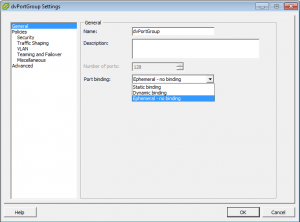Short answer = NO. Long answer = YES. I was working with a customer a couple of weeks ago and they asked the question, how do we configure the Anti-Affinity rules within VMware vCloud Director. Another guy asked the question, why would you want to use these? Think of a use case where within a vApp you have two or three web servers (for resilience). You would not want these to be on the same host, in-case of an outage. Yes HA would restart the VMs on a different host, but of course there is an outage time for that. This is where the anti-affinity rules have always been used within DRS to ensure the VMs are separated. If you were not concerned about the outage, you would simply have one web server. So going back to the title can it be done? Yes, but unfortunately not through the GUI […]
Tag Archives | 4.0

Ephemeral Ports – What are they?
A few people have been asking what Ephemeral ports are and what is there purpose. This is a quick overview. So what is an Ephemeral port? An Ephemeral Port stops the binding of a dvPort. This resembles the same behaviour in the standard vSwitch. This can be used when port history is not required or relevant. You can see on the screen shot below the three types of Port Binding available on a dvSwitch port group. The three types of port binding available: Static Binding (Default): means that the dvPort will be assigned to the VM at configuration time. Once all the ports are “booked” by VMs, it will not be possible to connect another VM, even if the connected VMs are powered up or not. Dynamic Binding: means that the dvPort will be assigned at the moment of VM power-up. This option allows for over committing the number of […]
Concurrent vSphere Client Connections Limit
There has been some discussions around what the total number of VMware vCenter Concurrent vSphere Client Connections is. Currently there is no limit, but it is recommended to keep this at a total of 30. Anything over this total and performance issues may be experienced. It also depends on how you use the vSphere Client. If you have fewer entities opened in the inventory tree, your vSphere Client puts less burden on the vCenter server therefore it may support more vSphere Client without noticeable performance downgrade. Why? Because for every opened managed entity like virtual machine, the vSphere Client asks vCenter to monitor its status using vSphere PropertyCollector API. The more to monitor, the more burden on the vCenter of course. Thanks to Steve Jin (DoubleCloud.org) for providing the above information.
The New Resource Pool option is grayed out
So today I have been building my home cloud, and came across a little useful point that I had forgot about. When you try to create a resource pool within a cluster, the New Resource Pool… Menu option is greyed out. Now for a couple of seconds I was a little confused, why is this? Then of course I remembered, I had not enabled DRS yet on my cluster (there is currently only one host). I enabled DRS and the option is now available. You can also find an VMware KB article on this here.
How To: Install VMware ESXi from USB
I haven’t done this in a long time, due to working on large customer accounts that use automated build processes to build all there ESXi servers, but I needed to do this for my home lab, so thought I would post how to configure a USB key to boot into the ESXi installer. Handy if you have no CD/DVD drives. I used Windows to carry out this. 1) Download the latest version of Syslinux. Current version (At the time of writing) 4.02 – Download here 2) Insert the USB key. It will require about 300 MB free space for the ESXi install files and should be formatted as FAT32. 3) Run c:syslinuxwin32syslinux.exe <drive letter> – This alters the boot partition on the USB key and copy over the file ldlinux.sys to the root directory. 4) Mount the ESXi Install ISO and copy the contents to the USB key. 5) On […]
